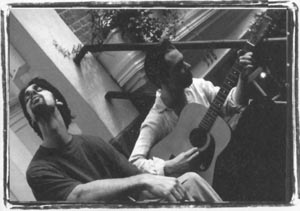Industrial Tepee
What Divine Engine
M o t h e r W e s t
by
Darren Paltrowitz and Karena Bernard
What's really in a name these days? I mean, a name like Industrial
Tepee would lead the listener to conclude that this is an industrial, or possibly
gothic act. However, you know what mother always said about jumping to conclusions...
 Much to
my surprise, I found "What Divine Engine", released October, 1998, to be
a multi-genre, yet consistent album. Consistently good, that is. This, their third
release, is tight blend of melodic and harmony laced acoustic and electric material
that calls to mind Gin Blossoms, Teenage Fanclub or Dire Straits.
Much to
my surprise, I found "What Divine Engine", released October, 1998, to be
a multi-genre, yet consistent album. Consistently good, that is. This, their third
release, is tight blend of melodic and harmony laced acoustic and electric material
that calls to mind Gin Blossoms, Teenage Fanclub or Dire Straits.
When
Charles Newman of Mother West Records heard "Groove Queen of the
21st Century", he asked the band to record it for a compilation. It went so
well that Charles decided to produce a full-length CD on Mother West. The band recorded
ten additional songs in less than a week and added five tunes from a set of songs
called the StonyBrook Sessions, produced at the home of close friend, Claude
Coleman, jr. , drummer of Ween, and along with Newman, producer of "What
Divine Engine."
"What
Divine Engine" begins with "Crawling To Heaven", a combination of
dissident guitars with light, yet heavily distorted vocals. As soon as you begin
to believe that Industrial Tepee is just another (feel free to shudder now...) modern
rock act, "At The Gun Show" boasts both clean acoustic and electric instrumentation,
with a sweet tune that is quite hum-worthy. Towards the middle of the album appears
"Lucky Day", an honest, melodic number that shows chorus harmony/background
vocals ala Jakob Dylan. On a strange twist from all that is heard prior, "Viva
Las Nowhere" is a Spanish/Classical style guitar-based ballad that will hold
your undivided attention.
This, their third
release, is tight blend of melodic and harmony laced acoustic and electric material...
Among the
more alternative tracks is "Highway Buddha". Within the song's opening
seconds, the bass solo may spark a slight reminder of the Pink Floyd classic
"Money". However, by its third or fourth repetition, you see that riff
to be holding its own, creatively. Soon after, distorted vocals (much reminiscent
of Anthony Kiedis, circa 1988) are added above a strong bass groove and tight
percussion. Then, just as I had the album pegged as going in the direction of Soul
Coughing, the next song, "New York City Is Paradise", displays a
Phish-like four part harmony boosted by a top notch drum solo.
Industrial
Tepee is the brainchild of Tom Shaner, who began playing in the subways while
attending N.Y.U. in the early 90's. Gigging at various east village coffee houses
and clubs led to an offer to record for PNYM Records. In 1992 guitarist and
songwriter Bob Sharkey joined up with Tom Shaner as a 'Tepee' mainstay. While
there are a number of contributors to the recorded material, the touring band is
completed with bassist John Turner and drummer Josh Margolis. An added
plus is that Industrial Tepee's rich lyrics often show story-telling or elusively
poetic qualities, so put aside your preconceptions and take in the diversely influenced
"What Divine Engine".
©TransAction
Magazine All Rights Reserved

 Much to
my surprise, I found "What Divine Engine", released October, 1998, to be
a multi-genre, yet consistent album. Consistently good, that is. This, their third
release, is tight blend of melodic and harmony laced acoustic and electric material
that calls to mind Gin Blossoms, Teenage Fanclub or Dire Straits.
Much to
my surprise, I found "What Divine Engine", released October, 1998, to be
a multi-genre, yet consistent album. Consistently good, that is. This, their third
release, is tight blend of melodic and harmony laced acoustic and electric material
that calls to mind Gin Blossoms, Teenage Fanclub or Dire Straits.